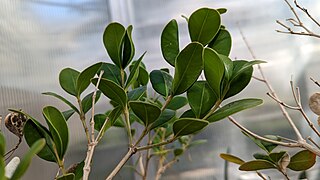
The Jebel Akhdar or Al Jabal Al Akhdar, is part of Al Hajar Mountains range in Ad Dakhiliyah Governorate of Oman. It rises to a height of 2,980 m (9,780 ft) and encompasses the Saiq Plateau at 2,000 m above sea level. Jebel Akhdar is famous for its labyrinth of wadis and terraced orchards, where pomegranates, apricots and roses grow in abundance due to its mild Mediterranean climate.

The Southwestern Arabian montane woodlands is a xeric woodland ecoregion in the southwestern Arabian Peninsula.

Euryops is a genus of flowering plants in the sunflower family. They are native mostly to rocky sites in southern Africa, with a few species in other parts of Africa and on the Arabian Peninsula. They produce daisy-like flowerheads from fern-like foliage. The name Euryops is probably a contraction of the Greek words ευρυς meaning 'wide,' and ὄψις meaning 'eye,' possibly referring to the large flowerheads compared to the narrow leaves.

Dactyloctenium is a genus of Asian, African, and Australian plants in the grass family. There are about 13 species in the genus in the world, in which 3 are known to occur in India. A common name for the plants is crowfoot grasses.

Lichtenstein's sandgrouse is a species of bird in the Pteroclidae family, which is named after Martin Lichtenstein. They are nomadic, mostly nocturnal birds, which drink before dawn and after dusk.

The Ethiopian large-eared roundleaf bat is a species of bat in the family Hipposideridae. It is found in Djibouti, Eritrea, Ethiopia, Kenya, Saudi Arabia, and Somalia. Its natural habitats are dry savanna, subtropical or tropical dry shrubland, caves, and hot deserts.

The Socotra Island xeric shrublands is a terrestrial ecoregion that covers the large island of Socotra and several smaller islands that constitute the Socotra Archipelago. The archipelago is in the western Indian Ocean, east of the Horn of Africa and south of the Arabian Peninsula. Politically the archipelago is part of Yemen, and lies south of the Yemeni mainland.
Urochondra is a genus of plants in the grass family. The only known species is Urochondra setulosa, native to northeastern Africa and southwestern Asia. The species grows in coastal sand dunes, salt marshes and estuaries.

The Ethiopian xeric grasslands and shrublands ecoregion is a semi-desert strip on or near the Red Sea and the Gulf of Aden coasts in Eritrea, Ethiopia, Djibouti and Somaliland. This ecoregion lies mainly between sea level and 800 meters (m) elevation. There are, however, many hills and massifs, which range up to 1300 m as well as outstanding fault-induced depressions, such as the Danakil, lying as low as 155 m below sea level. This region is extremely active tectonically, experiencing many earthquakes and intermittently active volcanoes. Rainfall is very low and yearly averages range from 100 to 200 millimeters (mm), with less rain falling closer to the coast. There are many species of interest, including the endemic Archer's lark, a species of dragon tree, and a large suite of desert ungulates, including the last viable population of African wild ass.

Tephrosia apollinea is a legume species, native to southwest Asia and northeast Africa.
The wildlife of Yemen is substantial and varied. Yemen is a large country in the southern half of the Arabian Peninsula with several geographic regions, each with a diversity of plants and animals adapted to their own particular habitats. As well as high mountains and deserts, there is a coastal plain and long coastline. The country has links with Europe and Asia, and the continent of Africa is close at hand. The flora and fauna have influences from all these regions and the country also serves as a staging post for migratory birds.

The wildlife of Saudi Arabia is substantial and varied. Saudi Arabia is a very large country forming the bulk of the Arabian Peninsula. It has several geographic regions, each with a diversity of plants and animals adapted to their own particular habitats. The country has several extensive mountain ranges, deserts, highlands, steppes, hills, wadis, volcanic areas, lakes and over 1300 islands. The Saudi Arabian coastline has a combined length of 2640 km and consists of the Gulf of Aqaba and the Red Sea to the west while a shorter eastern coastline can be found along the Persian Gulf.

Suaeda vermiculata is a species of plant in the family Amaranthaceae. It is a salt-tolerant plant (halophyte) that grows naturally in salt-affected areas.

The Southwestern Arabian foothills savanna, also known as the Southwestern Arabian Escarpment shrublands and woodlands, is a desert and xeric shrubland ecoregion of the southern Arabian Peninsula, covering portions of Saudi Arabia, Yemen, and Oman.
The Apostolic Delegation to the Arabian Peninsula, originally the Apostolic Delegation to the Red Sea Region, represents the interests of the Holy See to officials of the Catholic Church, civil society, and government offices to several nations in the region. The Holy See and the governments of those countries have not established diplomatic relations and the position of Apostolic Delegate is not a diplomatic one, though the Delegate is a member of the diplomatic service of the Holy See.

The South Arabian fog woodlands, shrublands, and dune is an ecoregion in Oman and Yemen. The fog woodlands lie on mountainsides which slope southeastwards towards the Arabian Sea. The mountains intercept moisture-bearing winds from the Arabian Sea, creating orographic precipitation and frequent fogs that sustain unique woodlands and shrublands in a desert region.

Sideroxylon mascatense is a species of flowering plant in the family Sapotaceae.
Schweinfurthia is a genus of flowering plants belonging to the family Plantaginaceae. It is also in Tribe Antirrhineae.

The Socotran pipistrelle or Lanza's pipistrelle is an endangered species of vesper bat in the family Vespertilionidae. It is endemic to Socotra Island in Yemen, and is the only mammal thought to be endemic to the island.

Buxus hildebrandtii is a species of shrub or small tree native to the Horn of Africa.

















